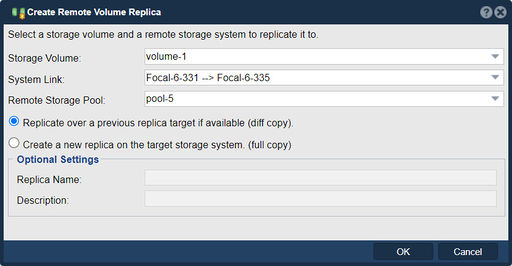Create Volume Replica

The purpose of creating a "Remote Volume Replica" in QuantaStor is to establish a replication relationship between two storage volumes, where one volume serves as the source or primary volume, and the other volume acts as the replica or secondary volume. This feature enables data replication and synchronization between the volumes, providing data protection, disaster recovery, and high availability capabilities.
If diff mode is chosen, then the new remote volume replica is created as a checkpoint where only the deltas are sent since the last replication. If full is selected, a new replica volume is created where all the data is resent.
Here are the main purposes and benefits of creating a Remote Volume Replica in QuantaStor:
- Data Protection and Redundancy: By creating a replica of a primary volume, you can ensure data protection and redundancy. Any changes made to the primary volume are replicated to the remote replica, providing an additional copy of the data. In case of data loss, corruption, or hardware failure in the primary volume, the replica can be utilized to restore the data, ensuring data availability and mitigating the risk of data loss.
- Disaster Recovery: The Remote Volume Replica feature enables disaster recovery capabilities. In the event of a site failure or a major data loss in the primary volume, the replica volume can be promoted to become the primary volume, allowing for seamless failover and minimizing downtime. This helps in maintaining business continuity and reducing the impact of disasters.
- High Availability: Creating a remote volume replica allows for high availability of data. By synchronizing data changes between the primary and replica volumes, the replica volume can be used for failover operations, ensuring continuous data access and minimizing service disruptions. In a clustered environment, the replica can be part of an active-passive configuration, where the replica volume is automatically activated in case of a primary volume failure.
- Data Synchronization: The Remote Volume Replica feature facilitates the synchronization of data between the primary and replica volumes. Changes made to the primary volume, such as writes or modifications, are replicated to the replica volume to ensure consistency and data integrity. This synchronization can occur in near-real-time or scheduled intervals, depending on the configuration.
- Recovery Point Objective (RPO) and Recovery Time Objective (RTO): By creating a remote volume replica, you can establish specific recovery point objectives and recovery time objectives. The RPO determines how much data loss is acceptable, while the RTO defines the maximum acceptable downtime. The replica volume helps in achieving these objectives by providing a recent copy of the data and enabling faster recovery in case of failures or disasters.
- Geographical Redundancy: The Remote Volume Replica feature allows you to create replicas across geographically distributed locations. This provides geographical redundancy, protecting against localized disasters, such as site failures, natural disasters, or network outages. It ensures that data is replicated and available in multiple locations, reducing the risk of data loss or unavailability.
It's important to note that specific configurations and options for creating a Remote Volume Replica in QuantaStor may vary based on the version and capabilities of the software. Therefore, referring to the official documentation or contacting the OSNexus support team for accurate instructions and guidance on creating Remote Volume Replicas in QuantaStor is recommended.
Navigation: Remote Replication --> Volume & Share Replica Associations --> Remote Replication --> Create Volume Replica (toolbar)
For additional information see Remote Replication Configuration